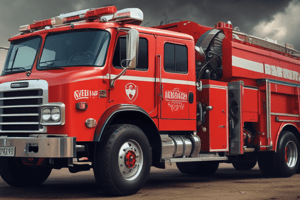Podcast
Questions and Answers
Who is responsible for ensuring that each member of their crew assigned the responsibility of driving are adequately trained?
Who is responsible for ensuring that each member of their crew assigned the responsibility of driving are adequately trained?
- Staff persons in the vehicle
- Company Officers (correct)
- TFS personnel acting as a driver
- Captain or Acting Captain of the section
What should a driver ensure while driving a TFS vehicle?
What should a driver ensure while driving a TFS vehicle?
- Keep headlights on at all times (correct)
- Use high beams only during night driving
- Maintain a speed of at least 60 km/h
- Drive with one hand on the wheel
What should a driver practice while driving a TFS vehicle?
What should a driver practice while driving a TFS vehicle?
- Defensive driving (correct)
- Aggressive driving
- Tailgating
- Rapid acceleration
What should a driver be knowledgeable about regarding their apparatus?
What should a driver be knowledgeable about regarding their apparatus?
What should a driver ensure regarding the TFS vehicle?
What should a driver ensure regarding the TFS vehicle?
What should a driver obey while driving a TFS vehicle?
What should a driver obey while driving a TFS vehicle?
Who is responsible for fines/charges issued on TFS vehicles?
Who is responsible for fines/charges issued on TFS vehicles?
What must drivers do if involved in a collision?
What must drivers do if involved in a collision?
When should drivers use their emergency warning lights?
When should drivers use their emergency warning lights?
What is the primary consideration for drivers when determining their speed?
What is the primary consideration for drivers when determining their speed?
What is a key difference between driving fire apparatus and driving cars?
What is a key difference between driving fire apparatus and driving cars?
Why should drivers use their auxiliary braking system?
Why should drivers use their auxiliary braking system?
What is the recommended procedure for parking fire apparatus?
What is the recommended procedure for parking fire apparatus?
What should drivers do before putting their apparatus into motion from a parked position?
What should drivers do before putting their apparatus into motion from a parked position?
What is the responsibility of drivers when it comes to fines or charges related to TFS or City vehicles?
What is the responsibility of drivers when it comes to fines or charges related to TFS or City vehicles?
What is the primary goal of the driver when leaving the fire apparatus?
What is the primary goal of the driver when leaving the fire apparatus?
Study Notes
Purpose and Responsibility
- Toronto Fire Services (TFS) personnel must be familiar with their apparatus and laws governing its operation for non-emergency driving.
- Company Officers are responsible for ensuring their crew members are adequately trained and drive safely.
- Drivers are responsible for fines/charges issued on TFS vehicles in non-emergency situations.
Driving Conduct
- Drivers must not compromise safety of the crew or public.
- TFS apparatus drivers must be in complete control of their vehicle at all times.
- Defensive driving must be practiced by all TFS personnel.
- Headlights must be kept on at all times while driving.
Vehicle Operation
- Drivers must operate apparatus in a manner that respects vehicle care and mechanical preservation.
- Drivers must obey the Highway Traffic Act (HTA) and municipal traffic regulations and signage.
- Drivers must be aware of the effect of weight and speed on braking and total stopping distance.
- Drivers must be knowledgeable of proper guidelines to follow in case of a collision.
Speed and Safety
- Drivers must drive within posted speed limits and at a rate of speed prudent to traffic, weather, and conditions.
- Drivers must maintain complete care and control of their apparatus.
- Drivers must be knowledgeable of handling characteristics of large heavy fire apparatus.
Additional Guidelines
- Emergency warning lights and sirens must not be used during non-emergency travel.
- Drivers must use auxiliary braking systems if equipped and follow manufacturer recommendations.
- Apparatus must be parked so the unit is driven forward rather than reversed.
- Drivers must do a circle check of their apparatus before putting it into motion from a parked position.
- Drivers must follow Standard Operating Guideline A-BACK when backing into a fire station.
- The driver must always leave the fire apparatus in a state of readiness.
Studying That Suits You
Use AI to generate personalized quizzes and flashcards to suit your learning preferences.
Description
This quiz covers the care and control goals and responsibilities for Toronto Fire Services personnel operating apparatus during non-emergency driving operations.




